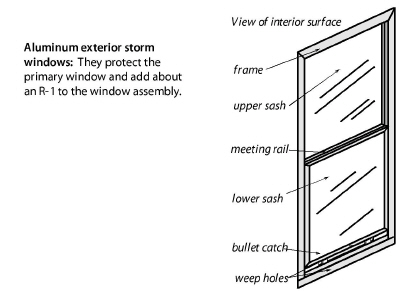
A storm window is an additional window installed outside or inside the primary window.
Exterior storm windows can save energy and preserve old worn primary windows from destructive weathering. You can attach exterior operable storm windows to the blind stop or exterior window casing of a double-hung window. Or, attach a fixed storm to any flat surface of a window frame or sash if the window is fixed or if a movable sash can support the extra weight.
Metal exterior storm windows are the best choice if they are well designed and installed properly.
• Choose operable storm windows to install on operable windows. Choose fixed storm windows to install on fixed windows or on sashes that open along with the movable primary window.
• If operable, make sure that the storm window opens and closes to allow the maximum amount of ventilation and egress area.
• Measure the storm-window dimensions according to where you’ll attach the storm: blind stop, window casing, or sash.
• Storm-window frames should have sturdy corners so they don’t rack out-of-square during transport and installation.
• Sashes must fit tightly in their frames.
• The gasket sealing the glass should surround the glass’s edge.
• Consider selecting a hard-coat low-e glass for the storm window, which should face the primary window to protect the low-e coating.
• The storm window should be sized accurately and should fit tightly in the opening.
• The storm window’s sashes should be removable from indoors for cleaning.

Follow these guidelines when installing storm windows.
ü Seal storm windows around the frame at time of installation with sealant tape or caulk.
ü Don’t allow the tape or caulk to interfere with the weep holes at the bottom of the frame. If weep holes aren’t manufactured into new storm window, drill weep holes or leave at least 2 two-inch spaces in sealant to allow water on the sill to escape.
ü Don’t allow storm windows to restrict emergency egress or ventilation through movable windows.
See also "Mobile home double window" on page 450.
Interior storm windows are usually more airtight than exterior storm windows because they must be airtight to avoid condensation and icing on the primary window during winter. Interior storm windows are usually a metal or plastic frame enclosing some type of plastic glazing.
Consider these specifications when selecting interior storm windows.
• Don’t install fixed interior storm windows on egress windows.
• Interior storm windows should have an airtight edge seal to prevent warm moist air from passing by the interior storm window and condensing or icing the interior of the glass on the primary window.
• Interior storm windows should be easily removable for storage.
• The home should have a safe place to store the storm windows seasonally.
• Consider using low-e glass or plastic for glazing to increase thermal resistance.